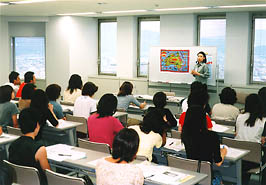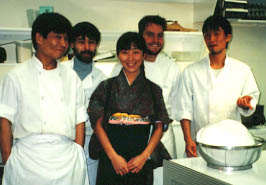|
 A
growing number of Japanese are heading overseas on working
holiday visas--a scheme enabling people aged 18 to 30 to stay and
work in Australia, Canada, New Zealand, and South Korea based on mutual
bilateral agreements with those countries. A
growing number of Japanese are heading overseas on working
holiday visas--a scheme enabling people aged 18 to 30 to stay and
work in Australia, Canada, New Zealand, and South Korea based on mutual
bilateral agreements with those countries.
The program began in December 1980
with Australia, in 1985 with New Zealand, and in 1986 with Canada. The
number of Japanese who visited these countries on such visas rose from
7,020 in 1988 to about 16,000 in 1998.
The number of countries with which
Japan has such an agreement has also grown. An accord was reached with
South Korea in April 1999, and Britain, France, and Germany are expected
to join the list as well.
Miho Nagao, 30, took advantage of
the visa to stay and work in Australia in 1993 and in New Zealand in
1996--both times for a period of a year. "I wanted to go abroad and
spend time in a country I like," she said. "I decided to use the system
since signing up for a formal exchange program would have been too costly,
and I didn't want to ask to my parents for help."
 She
first attended a local language school and later worked at a restaurant
and also as a tour guide. She said she made many friends through this
experience and learned to overcome her shyness in front of others. She
first attended a local language school and later worked at a restaurant
and also as a tour guide. She said she made many friends through this
experience and learned to overcome her shyness in front of others.
Some people who spent time in Canada
on the program said that time spent abroad enabled them to strengthen
their sense of independence, since visitors have to look after themselves.
Foreign Ministry officials say Japan
is now forging working holiday agreements with more countries, as the
program has produced very positive results. Prime Minister Keizo Obuchi
is a strong advocate of the program and has encouraged its expansion.
The rise in the number of people who are going on working holidays is
thanks to the fact that the system help them to broaden their horizons,
supporters say.
Photos: (From top) Meetings explaining how to get the
visas always attract crowds; Miho Nagao and her coworkers at a New Zealand
restaurant. (Japan
Association for Working Holiday Makers)
|

 A
growing number of Japanese are heading overseas on
A
growing number of Japanese are heading overseas on  She
first attended a local language school and later worked at a restaurant
and also as a tour guide. She said she made many friends through this
experience and learned to overcome her shyness in front of others.
She
first attended a local language school and later worked at a restaurant
and also as a tour guide. She said she made many friends through this
experience and learned to overcome her shyness in front of others.